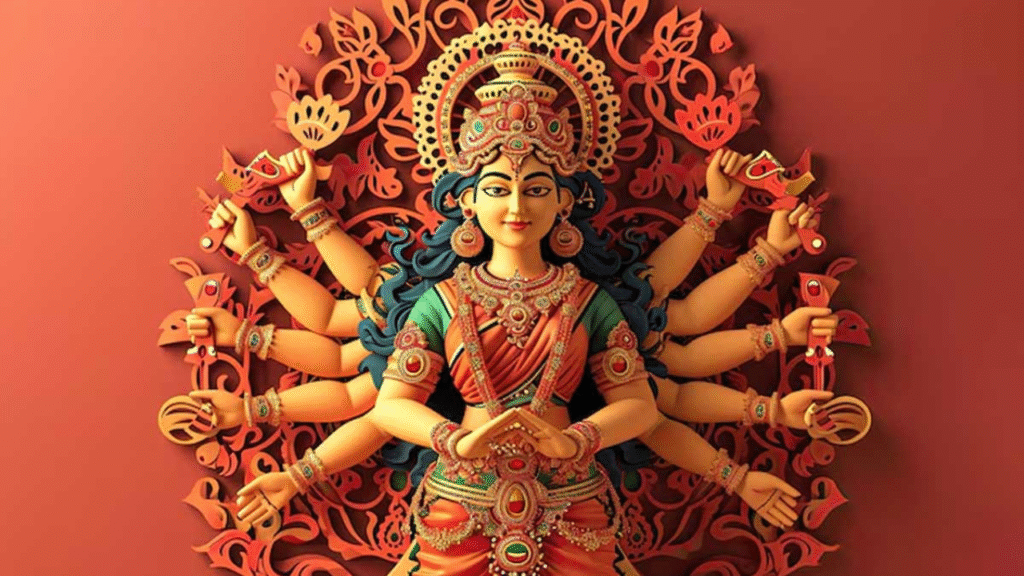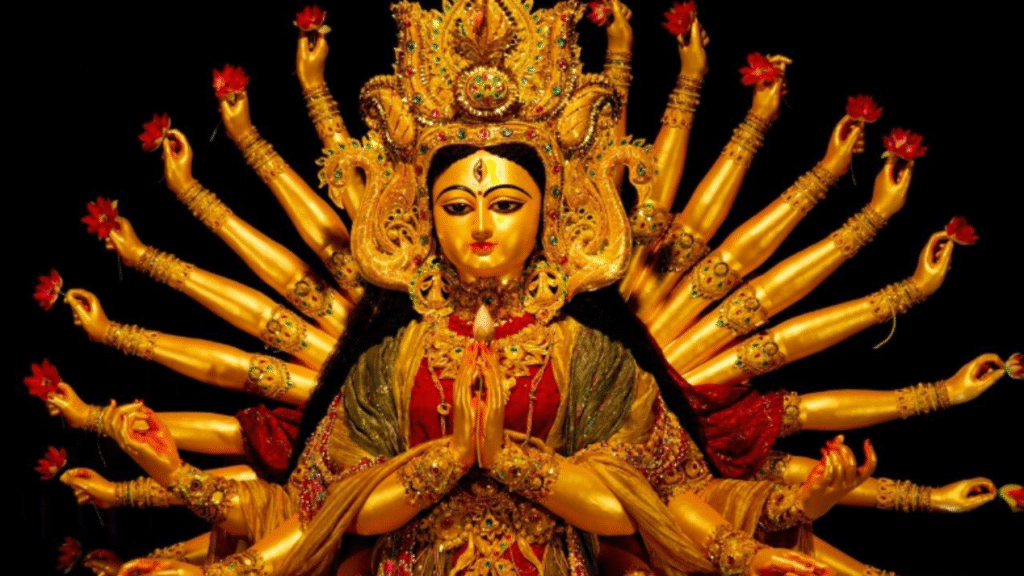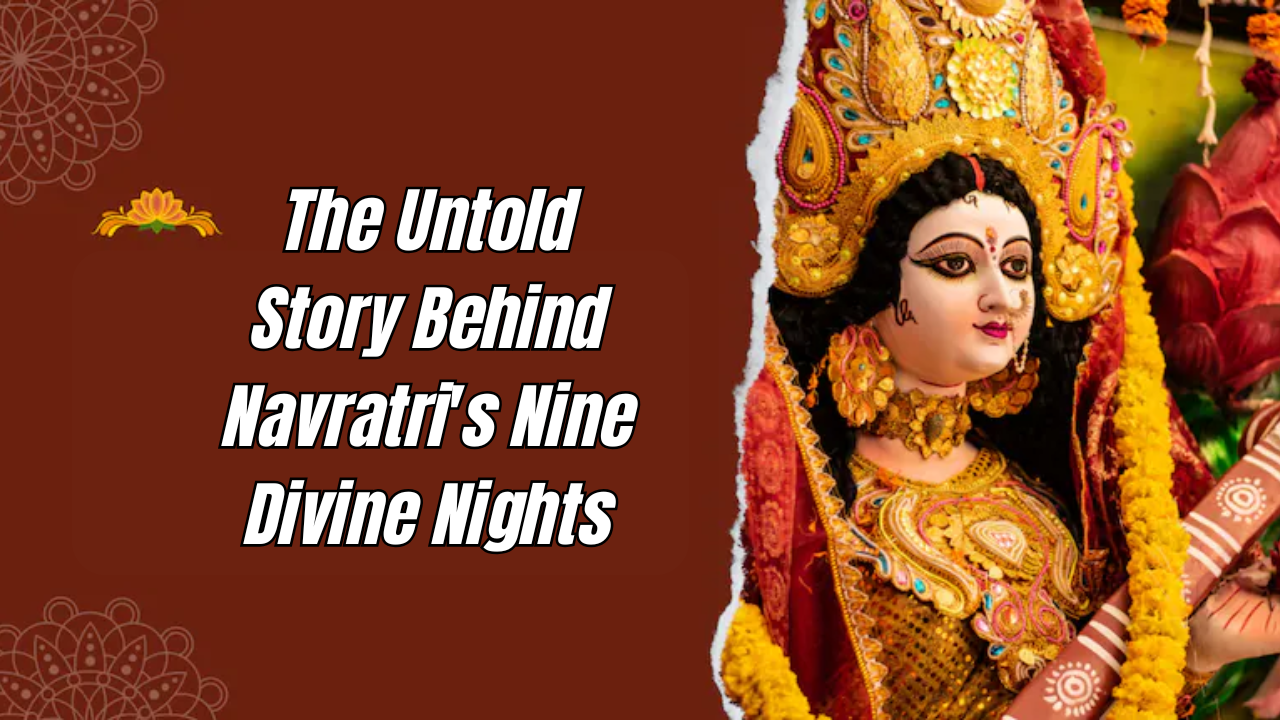1. Origins of Navratri: The Cosmic Battle of Good vs. Evil
The central mythological narrative behind Navratri is the battle between the Goddess Durga and the demon Mahishasura.
The Story of Mahishasura
Mahishasura, a powerful demon with the ability to shape-shift between human and buffalo form, gained immense power after receiving a boon from Lord Brahma that no man or god could defeat him. Arrogant and relentless, he waged war on the heavens, defeating even the mightiest gods.
In despair, the trinity of Brahma, Vishnu, and Shiva combined their powers to create Devi Durga — the supreme feminine force, Shakti. Armed with weapons from all the gods and mounted on a lion, Durga waged a nine-day war against Mahishasura, culminating in his death on the tenth day — Vijaya Dashami.
2. The Nine Forms of Durga: One Goddess, Nine Energies
Each day of Navratri is dedicated to one of the Navadurga, the nine manifestations of Goddess Durga. These forms reflect her evolution from the gentle to the fierce, from the nurturing to the victorious.
| Day | Goddess | Symbolism |
|---|---|---|
| 1 | Shailaputri | Daughter of the mountains, stability |
| 2 | Brahmacharini | Ascetic, devotion, discipline |
| 3 | Chandraghanta | Courage, serenity, balance |
| 4 | Kushmanda | Creator of the universe |
| 5 | Skandamata | Motherhood and protection |
| 6 | Katyayani | Warrior goddess, justice |
| 7 | Kalaratri | Dark and fierce, destroys evil |
| 8 | Mahagauri | Purity, peace, and compassion |
| 9 | Siddhidatri | Supernatural powers, wisdom |
Each form represents a step in the soul’s evolution, from the earthbound to the divine.

3. Spiritual Significance of Each Night
Navratri is not only a religious festival; it is a journey of inner transformation.
- First Three Nights: Represent Tamas, the destructive and purifying energy of the Goddess (Durga).
- Next Three Nights: Governed by Rajas, the active energy of Lakshmi, the goddess of wealth and prosperity.
- Last Three Nights: Dominated by Sattva, the pure spiritual energy of Saraswati, goddess of wisdom and enlightenment.
Each phase of Navratri mirrors our personal journey through purification, abundance, and awakening.
4. Regional Variations of Navratri Celebrations
West India – Garba and Dandiya in Gujarat
- Known for vibrant dances performed in circles, symbolizing the cycle of time.
- The Garba lamp at the center represents the divine feminine.
North India – Ramlila and Dussehra
- Enactments of Ramayana culminate in Ravana’s effigy burning on Vijaya Dashami.
- Navratri marks Ram’s victory over evil, paralleling Durga’s triumph.
East India – Durga Puja in Bengal
- Focuses on Maa Durga slaying Mahishasura.
- Elaborate idols, pandals, and immersion on Dashami.
- It’s also a homecoming of the goddess, like a daughter returning to her parents’ house.
South India – Golu and Saraswati Puja
- Homes display Golu dolls, symbolic of cosmic evolution.
- The ninth day is dedicated to Saraswati, and books/instruments are worshipped.
5. The Role of Fasting and Rituals
Fasting during Navratri is both spiritual and physical. It is believed to detox the body and prepare the mind for higher states of consciousness.
- Common fast practices include: fruits, milk, buckwheat, amaranth, potatoes.
- Abstaining from onion, garlic, grains, and alcohol helps in calming the senses.
- Rituals involve daily aarti, chanting mantras, lighting lamps, and offering bhog.
6. Astrological and Cosmic Importance
Navratri usually aligns with the lunar calendar in Ashwin (September–October) and Chaitra (March–April).
- These times mark seasonal shifts and are energetically potent.
- Aligns with equinoxes, a time of balance between light and dark.
- Fasting and spiritual practices are more effective due to reduced gravitational pull and cosmic disturbance.

7. Navratri as a Feminine Revolution
In a world where patriarchal systems dominate, Navratri serves as a spiritual celebration of feminine power — not just as a religious icon but as a force of nature.
- It reclaims the narrative of Shakti as the source of all creation.
- Empowers women to see themselves as goddesses — fierce, nurturing, wise, and indomitable.
8. The Psychological Symbolism
Every goddess is a projection of the human psyche:
- Durga slaying the demon reflects the inner battle against ego and ignorance.
- The nine nights are about discipline, devotion, and awakening of higher consciousness.
- On the tenth day, the ego is destroyed and the soul is liberated — hence, Vijaya Dashami or “Victory Day”.
9. Navratri Across the Globe
From New Jersey to Nairobi, global Indian communities now celebrate Navratri with grandeur:
- Community Garba nights
- Digital Durga Puja livestreams
- Eco-friendly pandals and biodegradable idols
- Cross-cultural participation from non-Hindus, turning it into a global festival of divine joy
Conclusion: Navratri as an Inner Journey
Behind the glamor, garba, and glitter lies the untold story of Navratri — a spiritual, psychological, and symbolic battle where the Divine Feminine reigns supreme.
Each night challenges us to:
- Face our inner demons
- Awaken our strength
- Cultivate wisdom
- Celebrate the sacred feminine within
In honoring Durga and her many forms, we’re not just celebrating mythology — we’re honoring the eternal cycles of destruction and rebirth within ourselves.
Navratri is not merely a cultural observance — it is an invitation to evolve.
Table: Overview of the Nine Nights of Navratri
| Day | Form of Durga | Color | Energy Aspect | Ruling Planet | Ritual Focus |
|---|---|---|---|---|---|
| 1 | Shailaputri | Grey | Rootedness | Moon | Grounding |
| 2 | Brahmacharini | Orange | Discipline | Mars | Fasting, Tapas |
| 3 | Chandraghanta | White | Courage + Calm | Venus | Aarti |
| 4 | Kushmanda | Red | Creative Force | Sun | Lighting lamps |
| 5 | Skandamata | Royal Blue | Protection | Mercury | Mother-child bond |
| 6 | Katyayani | Yellow | Warrior Spirit | Jupiter | Strength prayers |
| 7 | Kalaratri | Green | Dissolution | Saturn | Fearlessness |
| 8 | Mahagauri | Peacock Green | Purification | Rahu | Surrender |
| 9 | Siddhidatri | Purple | Enlightenment | Ketu | Meditation |
FAQs
1. Why does Navratri last nine nights?
Navratri spans nine days of devotion, while Durga Puja — especially in Bengal — focuses on the last five days and culminates in Dashami with the immersion of idols.
2. What is the difference between Navratri and Durga Puja?
Navratri spans nine days of devotion, while Durga Puja — especially in Bengal — focuses on the last five days and culminates in Dashami with the immersion of idols.
3. Can non-Hindus participate in Navratri?
Absolutely. Navratri welcomes all who wish to honor the divine feminine, regardless of religion or nationality. Many global celebrations are inclusive and multicultural.
4. Why are different colors worn each day?
Each day of Navratri has a corresponding planet, energy, and color that enhances the vibrational and symbolic experience of worship.
5. What is the spiritual purpose of fasting during Navratri?
Fasting purifies the body, quiets the mind, and enhances receptivity to divine energies. It also helps redirect focus from material to spiritual realms.
